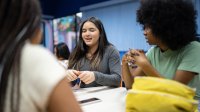A Protocol to Encourage Robust Classroom Discussions
This framework helps students find common ground when it comes to academics and social and emotional learning topics.
Your content has been saved!
Go to My Saved Content.In my instructional coaching work with schools, I’m often requested to model teaching strategies with students by teachers looking for ways to transform how their kids open up during classroom discussions and create common ground about both social and academic topics.
This can be challenging if young people are not ready to discuss or engage meaningfully in conversation because they are not emotionally compelled enough by the topic or unaware of how to do so comfortably. Some may need time to formulate their thoughts privately before expressing them. Some may need time to build a little background knowledge first. Others may be fine with the material but not ready to express their ideas openly.
For example, asking kids to explain the difference between sympathy and empathy in social and emotional learning (SEL) when they are unsure of how to define those terms may cause them to shut down. Similarly, discussions about academic concepts and practices can be tricky when students lack the declarative or procedural knowledge required for deep elucidation on applying the content.
In2Out Protocol
This can leave teachers to gloss over definitions and provide examples; unfortunately, the students’ cognition and voice aren’t part of the experience, conversations, or needed next steps. Using a structure like the In2Out protocol can provide both teachers and students the needed framing of content for self-learning, reflection, expression, and vibrant classroom discussions.
I was introduced to In2Out, created by the San Francisco Coalition of Essential Small Schools, by instructional designer Gina Olabuenaga through our project-based learning (PBL) training sessions. The protocol quickly became a staple in my teaching as a strategy for getting my learners to participate in meaningful discussions about various SEL and academic topics.
This sustainability unit from the environmental science book I coauthored with PBL expert James Fester suggests using In2Out with students to read and analyze a mock correspondence from a foundation they work for, outlining a task they need to complete. We find this helpful for having students discuss their need-to-knows and need-to-dos for completing tasks in a structured format.
Implementation of In2Out discussion can be a little clunky at first, but repetition enhances this skill. Once the class gets the hang of thinking and discussing through the prompts, the steps can promote deeper learning, reflection, classroom culture, and community.
Implementing In2Out in 3 Steps
1. (In) Written Reflection (4–5 minutes). This step is essential for priming students for discussion by having them write their thoughts—beginning with their own experiences. A powerful norm to lift up here is that they don’t share what they write with others. Instead, this is an opportunity to formulate their thoughts about the topic in a safe space.
Open the protocol by introducing a new unit/lesson, concept, or SEL topic to students. Although it’s not always necessary, you can complement what you’d like for them to reflect on with either a short video or reading to scaffold their thinking. Then introduce a question prompt, and allow them a few minutes to independently write their thoughts and reflections. Here are some good prompts:
- Describe a time you showed empathy to another peer. How were you able to share in their perspective?
- What specific strategy and steps did you use to solve a math problem last semester?
- What steps did your group take to form your research hypothesis in our last unit?
2. (2) Pair Share (4–6 minutes). This step requires the facilitator to share a prompt to help students make meaning and begin conversations with a peer. The protocol norm is to do this in pairs, but if your class doesn’t have even numbers, triads work too. Other helpful norms for holding space can include some of the following:
- Speak from the heart.
- Listen from the heart.
- Listen to gain the perspective of your classmate rather than responding.
- Share the space fairly by using a timer.
Here are some examples of prompts:
- Recall a time when a peer, teacher, or family member was empathetic toward another person. What were some of the ways that they showed empathy?
- Think of a time when a teacher introduced a new strategy for solving a math problem. How did they explain and model the process in ways that allowed you and other kids to understand what to do?
- What do you know about forming and proving a hypothesis? Why is it important to the investigation process?
3. (Out) Table Talk With Peers or Entire-Class Discussion. The final step is for broader discussion and reaching consensus about how to collaboratively commence with learning. Teachers introduce another prompt and can choose to make it a table talk with more than two peers or a whole-group discussion.
Not everyone will feel comfortable sharing in the larger setting. Teachers can ease concerns for kids by establishing that participation doesn’t always mean speaking. Listening with the intent of gaining perspective is also engagement and learning.
When I learned In2Out from Gina, she used a circle structure for allowing everyone to see and focus on the speaker(s). Implement it how your space allows, and focus on transforming classroom discussions. The norms from step two also work well here, and I would add that everyone may speak more than once but should allow three others to speak before speaking again.
Prompts may include the following:
- How do we know when empathy is part of our classroom culture, and how can each of us do our part?
- What can we do to ensure that the whole class can use strategies to solve math problems successfully?
- How can we ensure that everyone in our class is able to construct an informed hypothesis?
